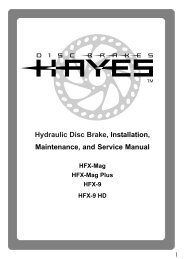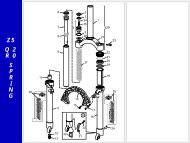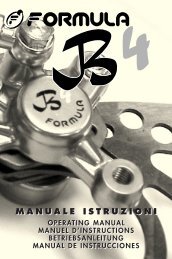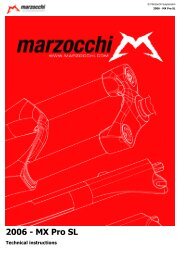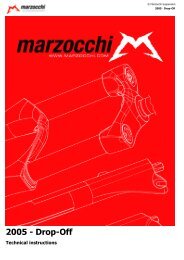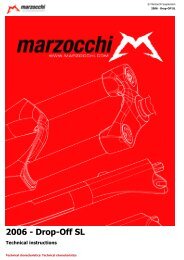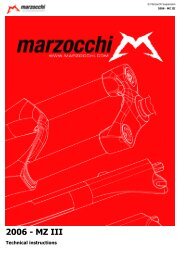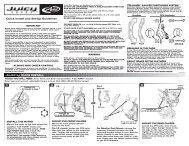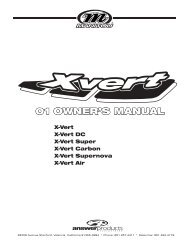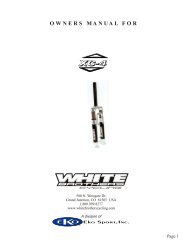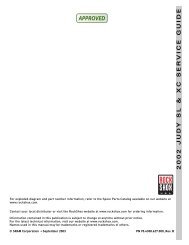2004 Rear Shock Owner's Manual - FOX - Birota
2004 Rear Shock Owner's Manual - FOX - Birota
2004 Rear Shock Owner's Manual - FOX - Birota
You also want an ePaper? Increase the reach of your titles
YUMPU automatically turns print PDFs into web optimized ePapers that Google loves.
Vanilla<br />
<strong>Shock</strong> Features<br />
Adjustable Spring Preload - External Coil Spring - Internal Floating Piston - Oil Damping<br />
One Piece Aluminum Body - One Piece Eyelet - Nitrogen Charged - Speed Sensitive Compression Damping<br />
Vanilla R<br />
<strong>Shock</strong> Features<br />
Adjustable Spring Preload - External Coil Spring - Internal Floating Piston - Oil Damping<br />
One Piece Aluminum Body - One Piece Eyelet - Nitrogen Charged - Speed Sensitive Compression Damping<br />
Multi-Valve Piston - 12 Click Externally Adjustable Rebound Damping - Speed Sensitive Rebound Valve Stack<br />
REBOUND ADJUSTER<br />
KNOB (RED)<br />
Rebound Adjustment<br />
Rebound damping controls the rate at which the shock returns after it has been compressed. The red adjuster dial<br />
can be turned clockwise for slower rebound and counter-clockwise for faster rebound. There is a wide range of<br />
adjustment enabling the rider to tune the shock to any air pressure and riding condition. The proper rebound setting<br />
is a personal preference and varies depending on rider weight, riding style and riding conditions. As a general rule,<br />
rebound should be as fast as possible without kicking back and pushing the rider off the saddle when riding the<br />
bicycle in rough terrain. If rebound is too slow the suspension will not function properly and the wheel will not follow<br />
the changing terrain. Determining the proper rebound setting may take a number of rides. Use the “curb test” to start<br />
dialing in your rebound setting. Do this test on flat ground where there is little auto traffic and plenty of room. Ride at<br />
normal cruising speed and stay seated. Ride off a curb and monitor the rebound. If the bike oscillates a few times<br />
after landing the rebound is too fast. If the shock does not return promptly it is too slow. Start with the dial in the<br />
middle (about 12 clicks from full slow) and adjust 4 clicks in the direction needed. Single clicks of adjustment can be<br />
used to fine tune the rebound damping. During the first few rides, adjust the rebound damping and note the different<br />
ride characteristics. Your rebound damping setting may change with different riding conditions.<br />
17




